In this guide I will walk through how to deploy BGPAlerter as a service in Amazon (AWS) as an ECS/Fargate container using a Github, Terraform, Drone Pipeline
What is BGPAlerter?
BGPAlerter is a well-engineered and useful tool built by Massimo Candela which allows you to monitor, in real-time, important BGP updates to your desired list of Prefixes and ASNs on the public internet.
The BGPAlerter application connects to public BGP data from these sources.
The user edits prefix.yml and config.yml files to setup desired monitoring and alerting/notifications.
Here is a Super High Level overview of the flow:
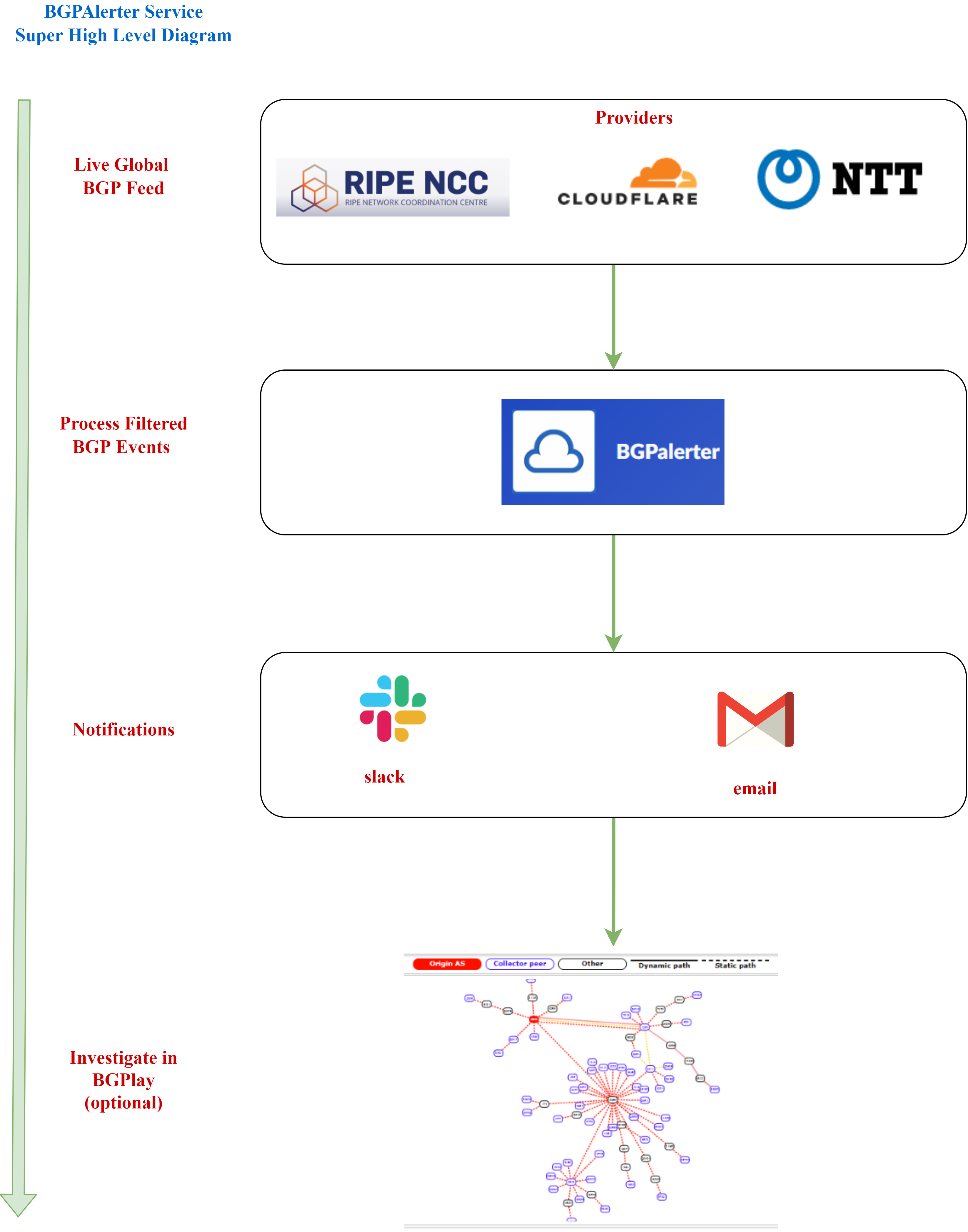
Live RIPE Feed Example
- Here is an example of the Live RIPE Feed of BGP Updates
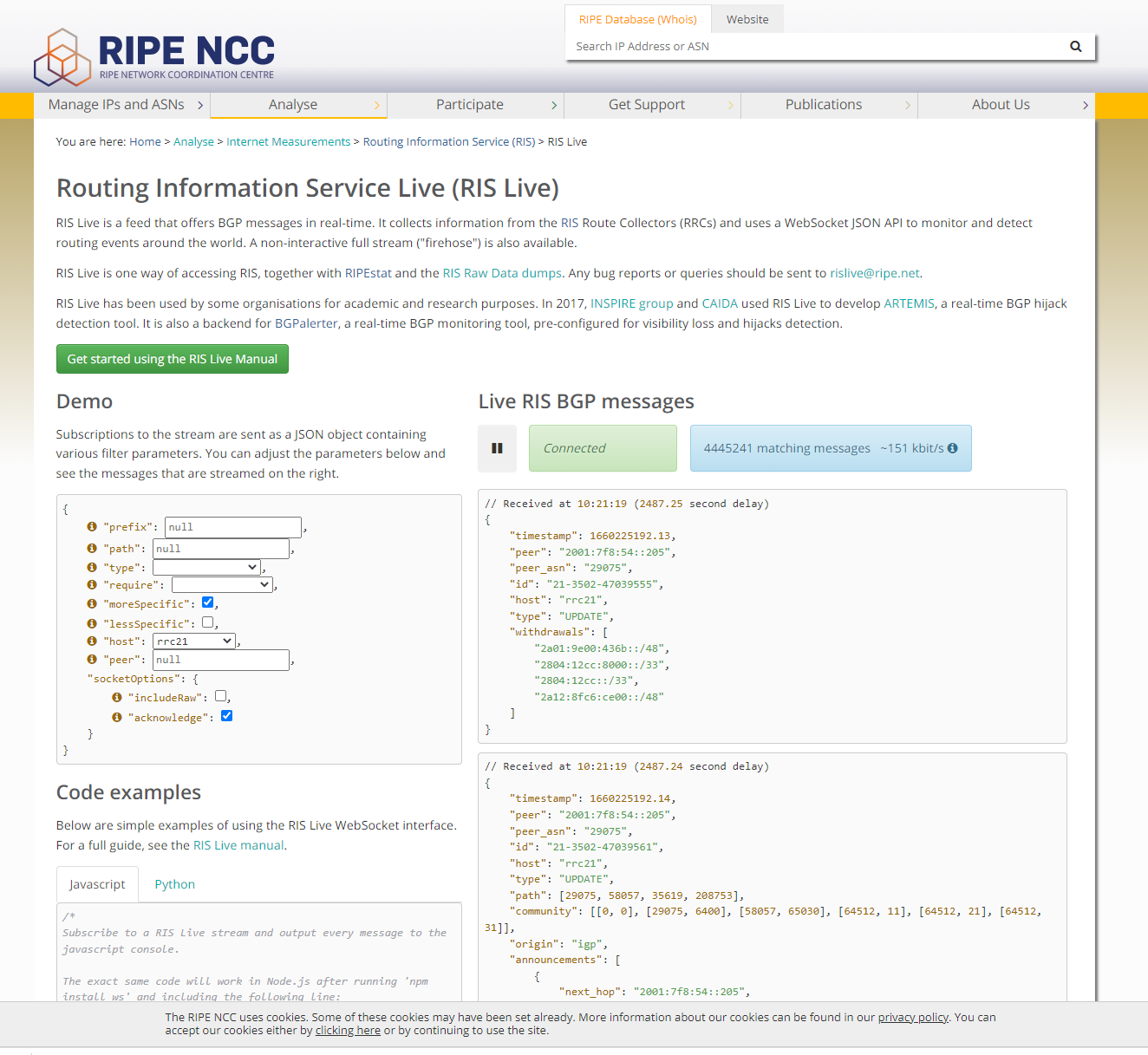
Why should we use Infrastructure as Code?
Network Engineers love tools, but oftentimes, the tools that Network Engineers deploy turn into bespoke pet projects that are hard to keep in sync, maintain or document.
- Infrastructure as code (IaC) helps alleviate these problems because it:
- Allows for version controlled configuration changes
- Self-documents (for the most part)
- Creates an easy-to-follow process for updating and maintaining the tool application and system environment
The Solution
High Level Diagram
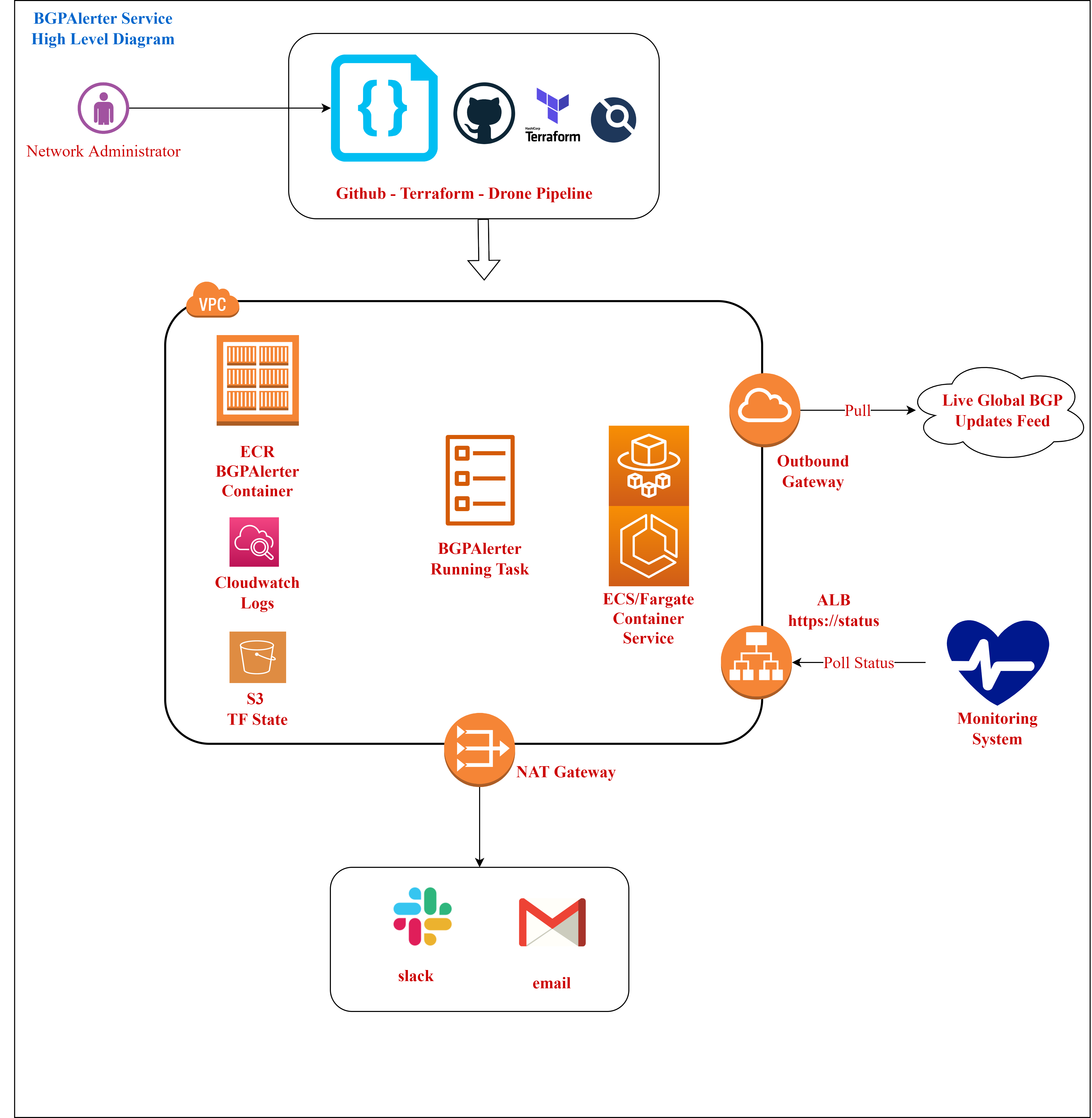
Drone Process

The Code
- Github Repo of the Code can be found here
- This repo and blog post are not meant to be “plug-and-play” ready, there are some parts of the infrastructure omitted (such as the VPC, Route53 etc)
- The key learning takeaways of this guide are how to format the drone.yml, Dockerfile, ecr.tf and ecs.tf files
- Credit goes to the devops folks at my org from whom I borrowed much of the terraform code and made my own tweaks as needed
prefix.yml
The source file that BGPAlerter reads of which prefixes and ASNs to monitor
1.1.1.0/23:
description: ABCDEFG
asn:
- 111111
ignoreMorespecifics: false
ignore: false
group: noc
2.2.2.0/24:
description: HIJKLMNOP
asn:
- 22222
ignoreMorespecifics: false
ignore: false
group: noc
3.3.3.0/21:
description: QRSTUVWXYZ
asn:
- 33333
ignoreMorespecifics: false
ignore: false
group: noc
options:
monitorASns:
'111111':
group: noc
upstreams:
- 55555
downstreams: []
generate:
asnList:
- '111111'
- '22222'
- '33333'
exclude: []
excludeDelegated: false
prefixes: null
monitoredASes: true
historical: true
group: noc
Dockerfile
Instructions that Drone uses to build your docker image. This image is later pushed to AWS ECR
### Pull latest bgpalerter container from nttgin docker hub
FROM nttgin/bgpalerter:latest
### Copy our own prefix.yml file and config file to the docker image
### When drone builds this image and pushes it to ECR, it will contain our files (not the defaults)
COPY bgpalerter/YOUR_ASN_PREFIX_LIST.yml /opt/bgpalerter/volume/YOUR_ASN_PREFIX_LIST.yml
COPY bgpalerter/config.yml /opt/bgpalerter/volume/config.yml
### Slack webhook should not be committed in code. This script replaces the slackwebhook in config.yml with a tf var
COPY bgpalerter/slack-token-replace.sh /opt/bgpalerter/volume/slack-token-replace.sh
### open port 8011 for status checks
EXPOSE 8011
Drone File
The Drone file are the steps that drone takes to build the infrastructure. This file consists of two sections
- First, build the docker image and push it to ECR
- Second, build the AWS Fargate infra from the terraform directory
---
### First pipeline creates the docker image from Dockerfile and pushes to your ECR repo
kind: pipeline
name: ecr
workspace:
path: XXX
steps:
### Drone pushes to ECR/bgpalerter and tags as latest + adds commit_sha
### The commit_sha is important because its how we force Fargate to always rebuild/redeploy the container on changes
- name: publish-image-local
image: plugins/ecr
settings:
registry: xxx.dkr.ecr.us-east-1.amazonaws.com
repo: bgpalerter
dockerfile: Dockerfile
tag:
- latest-${DRONE_COMMIT_SHA}
environment:
SHARED_CREDENTIALS_FILE: XXX
### When main changes, drone runs this pipeline
when:
event: push
branch: main
---
### The 2nd drone pipeline runs terraform code to build aws infrastructure
kind: pipeline
name: default
workspace:
path: XXX
steps:
### Format syntax check terraform files
- name: fmt-module
image: hashicorp/terraform
commands:
- cd terraform/modules/fargate-infra
- terraform fmt -check -diff=true
- name: fmt-aws
image: hashicorp/terraform
commands:
- cd terraform/aws
- terraform fmt -check -diff=true
### Build terraform plan file and sleep30 seconds. Giving admin time to abort
- name: prd-terraform-plan
image: hashicorp/terraform
commands:
- cd terraform/aws
- terraform init -input=false
- terraform plan -out=PLANFILE -input=false -lock-timeout=5m
- sleep 30
environment:
SHARED_CREDENTIALS_FILE: XXX
### Pass commit_sha so we can use it in terraform file to call our docker image
TF_VAR_image_tag_digest: ${DRONE_COMMIT_SHA}
when:
event: push
branch: main
### Deploy infra with terraform apply
- name: prd-terraform-apply
image: hashicorp/terraform
commands:
- cd terraform/aws
- terraform apply -input=false -lock-timeout=5m PLANFILE
environment:
SHARED_CREDENTIALS_FILE: XXX
### Pass commit_sha so we can use it in terraform file to call our docker image
TF_VAR_image_tag_digest: ${DRONE_COMMIT_SHA}
### When main changes, drone runs this pipeline
when:
event: push
branch: main
Slack Webhook Script
Slack Webhooks are sensitive, and should not be committed to Github. This script grabs the slackwebhook from a tf env variable and uses sed to load it into confi.yml. This is done before the BGPAlerter service is started on the container.
### This script is whats started on the docker container. First we replace the slackwebhook then start bgpalerter service
### Call SLACK_API_TOKEN from tf env variable which is stored in AWS Param Store
ESCAPED_REPLACE=$(printf '%s\n' "$SLACK_API_TOKEN" | sed -e 's/[\/&]/\\&/g')
/bin/sed -i "s/slacktokentobereplaced/$ESCAPED_REPLACE/g" /opt/bgpalerter/volume/config.yml
/bin/cat /opt/bgpalerter/volume/config.yml
/usr/local/bin/npm run serve -- --d /opt/bgpalerter/volume/
ECR Terraform File
Builds the Elastic Container Registry in AWS
###This file creates the ECR repository for the docker image.
resource "aws_ecr_repository" "app_image" {
name = "bgpalerter"
image_tag_mutability = "MUTABLE"
image_scanning_configuration {
scan_on_push = true
}
}
ECS Terraform File
Builds the Elastic Container Service in AWS
### ECS File creates the Fargate service for the docker container
### Sets CPU and RAM
### Creates the bgpalerter task definition and runs it
resource "aws_ecs_cluster" "bgpalerter-fargate" {
name = local.svc_name
capacity_providers = ["FARGATE_SPOT"]
default_capacity_provider_strategy {
capacity_provider = "FARGATE_SPOT"
}
tags = var.common_tags
}
// ECS service
resource "aws_ecs_service" "bgpalerter-svc" {
name = local.svc_name
cluster = aws_ecs_cluster.bgpalerter-fargate.id
task_definition = aws_ecs_task_definition.task_definition.arn
desired_count = 1
launch_type = "FARGATE"
network_configuration {
subnets = xxx
security_groups = [xxx]
}
load_balancer {
target_group_arn = xxx
container_name = xxx
container_port = xxx
}
tags = xxx
}
### Create BGPAlerter Task
resource "aws_ecs_task_definition" "task_definition" {
family = local.svc_name
requires_compatibilities = ["FARGATE"]
network_mode = "awsvpc"
execution_role_arn = xxx
task_role_arn = xxx
### CPU and Memory
cpu = 512
memory = 1024
tags = xxx
container_definitions = jsonencode([
{
name = local.svc_name
image = "${var.image_name}${var.image_tag_digest}"
essential = true
### Call the shell script when the image starts. This replaces the slack webhook and starts the service
entryPoint = ["/bin/sh", "/opt/bgpalerter/volume/slack-token-replace.sh"]
secrets = [
{
name = "SLACK_API_TOKEN"
valueFrom = xxx
}
]
portMappings = [
{
containerPort = 8011
hostPort = 8011
}
]
logConfiguration = {
logDriver = "awslogs"
options = {
awslogs-group = local.svc_name
awslogs-region = "us-east-1"
awslogs-stream-prefix = "bgpalerter"
}
}
}
])
}
The Results
Drone Build Progress
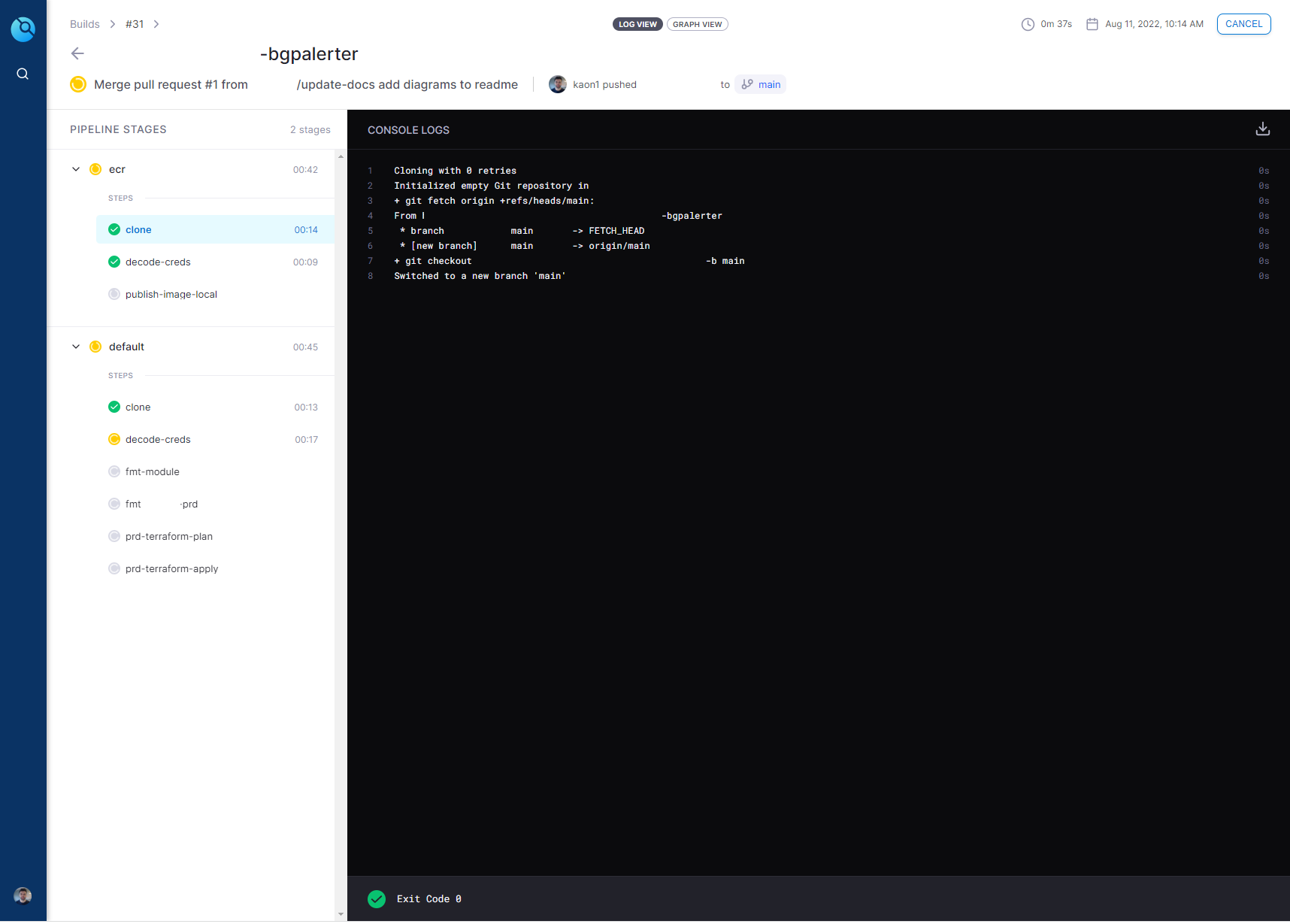
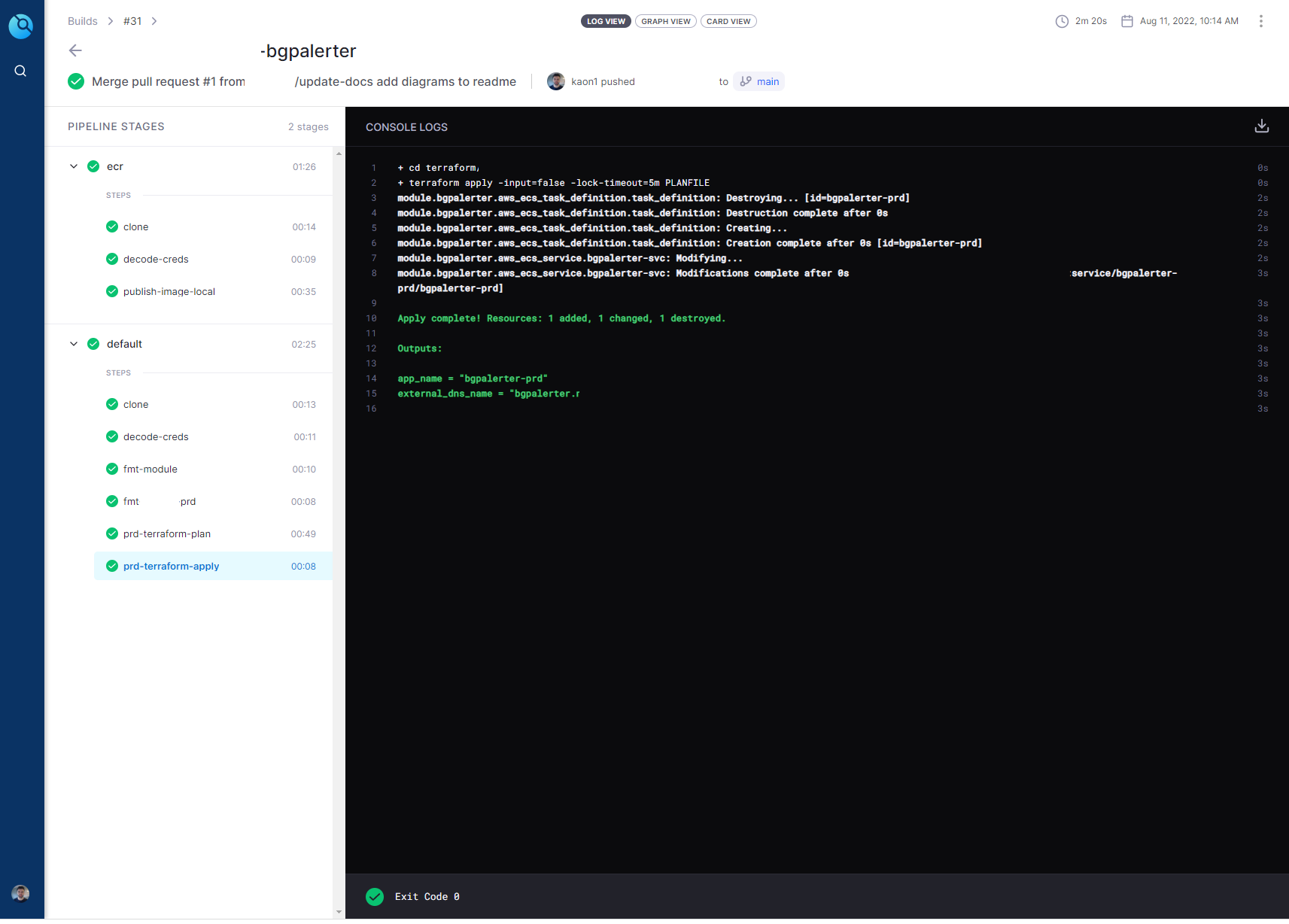
Deployed Infrastructure - Elastic Container Registry
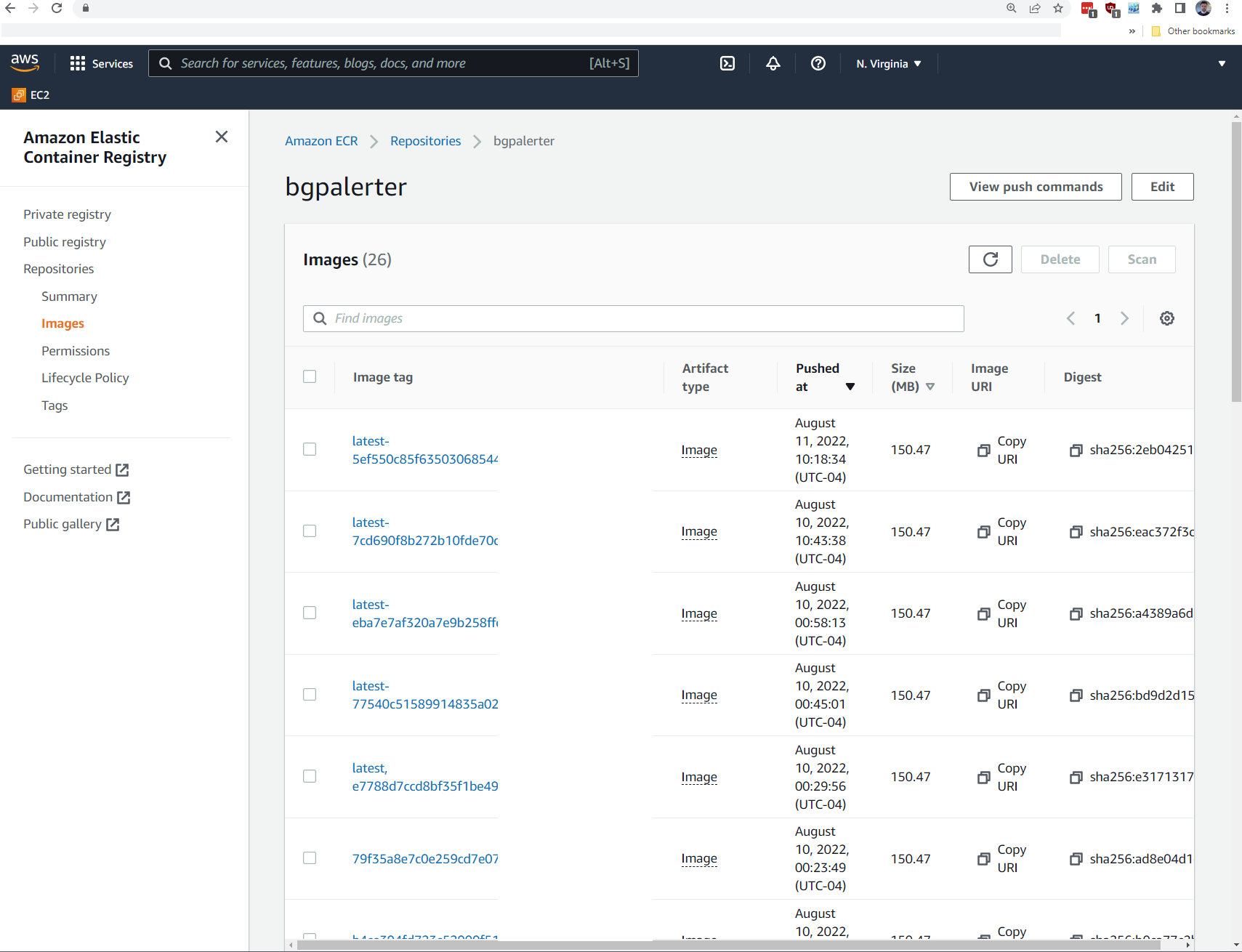
Deployed Infrastructure - Elastic Container Service and Fargate
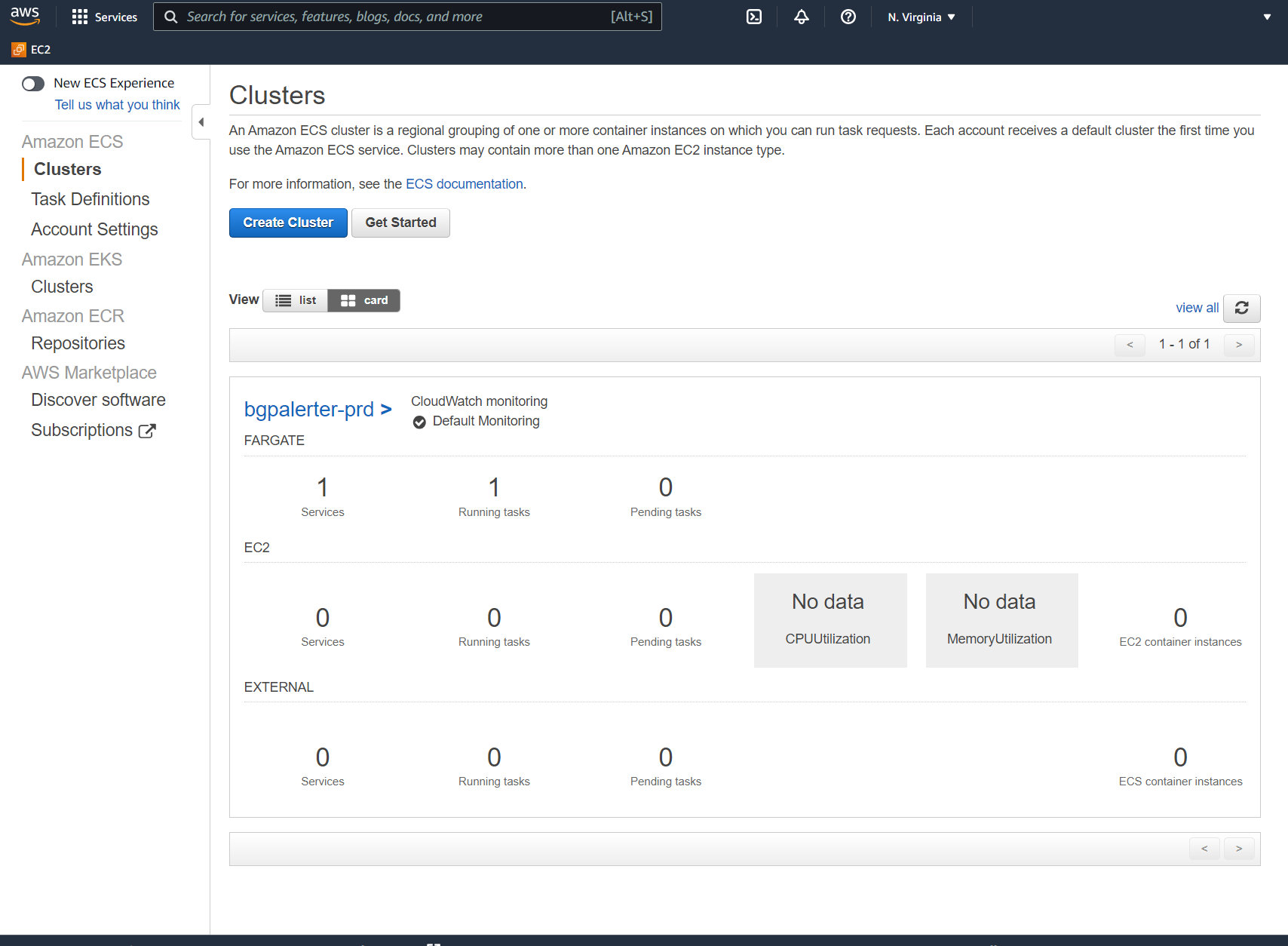
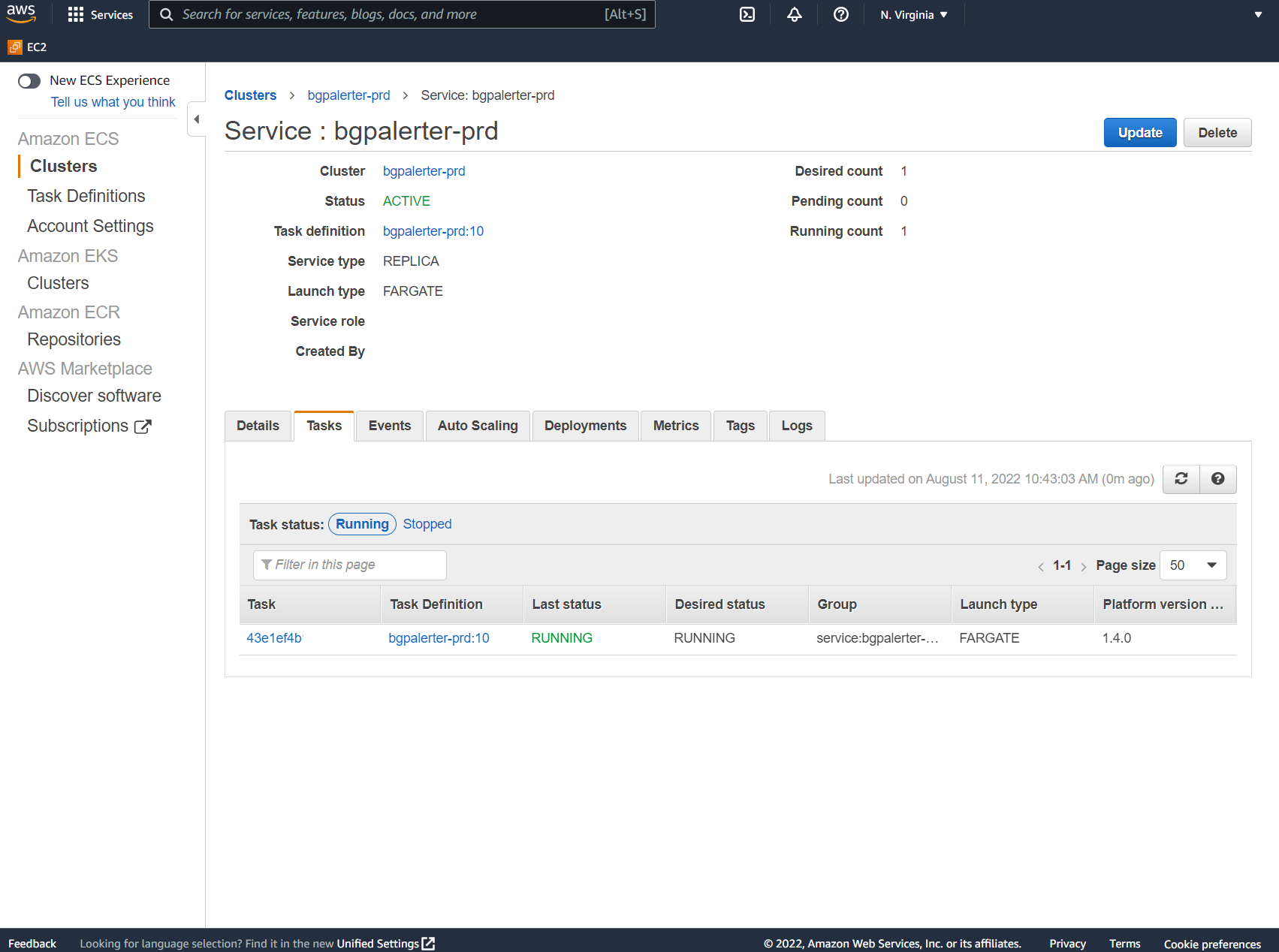
BGPAlerter Running and Status
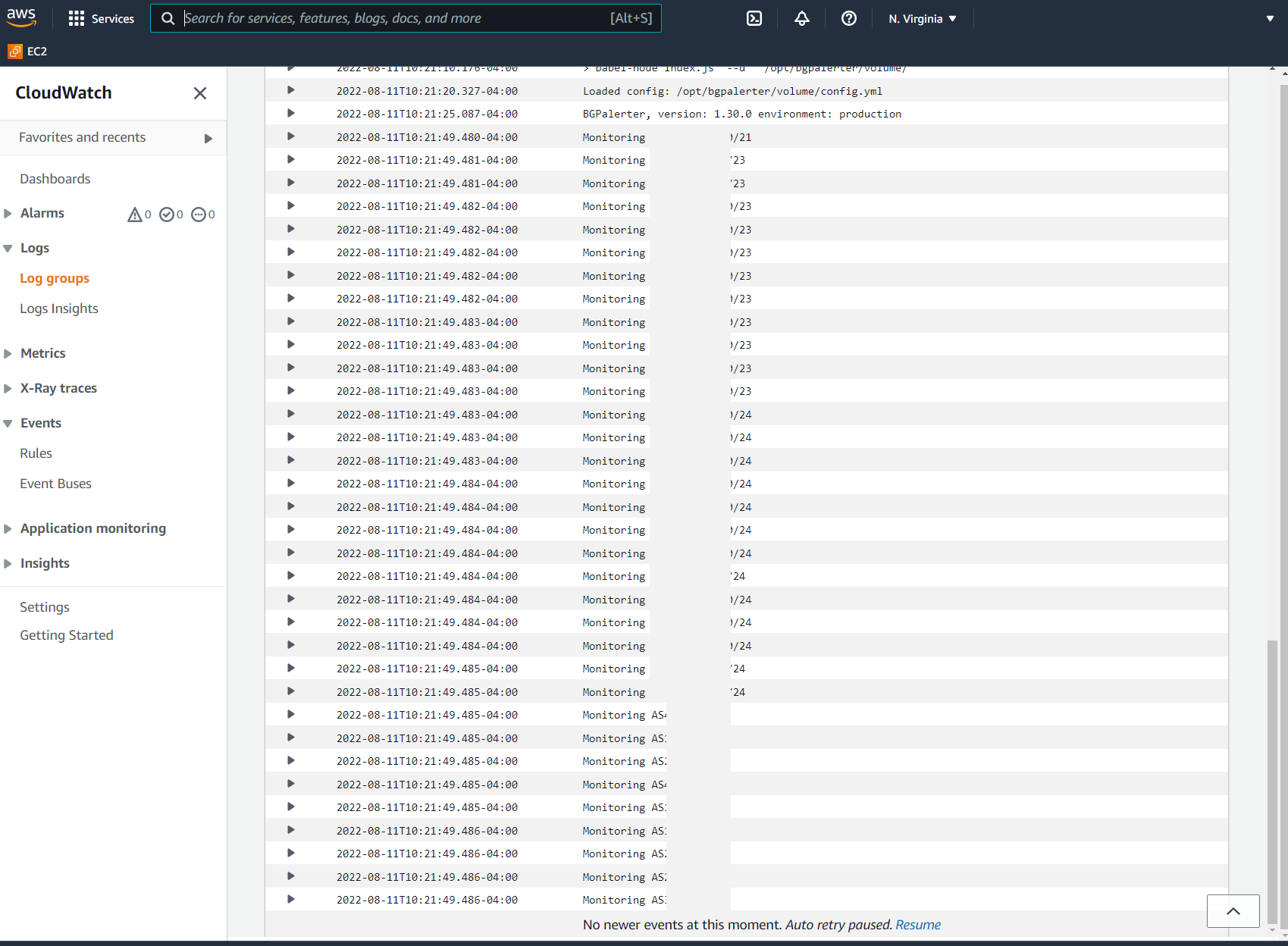

Notifications

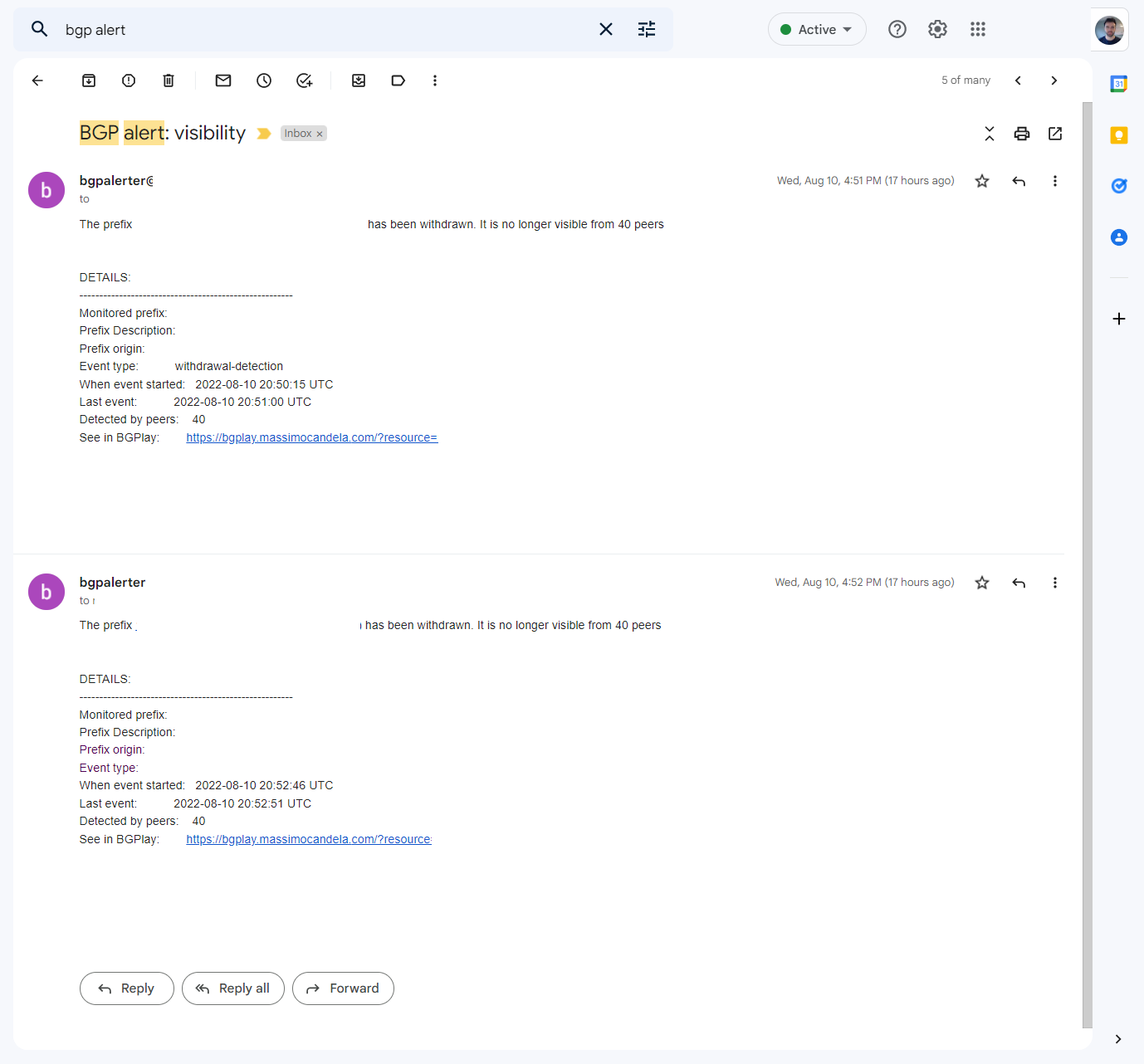
The Alert email provides a link to BGPLay which lets you view the event in a graphed form
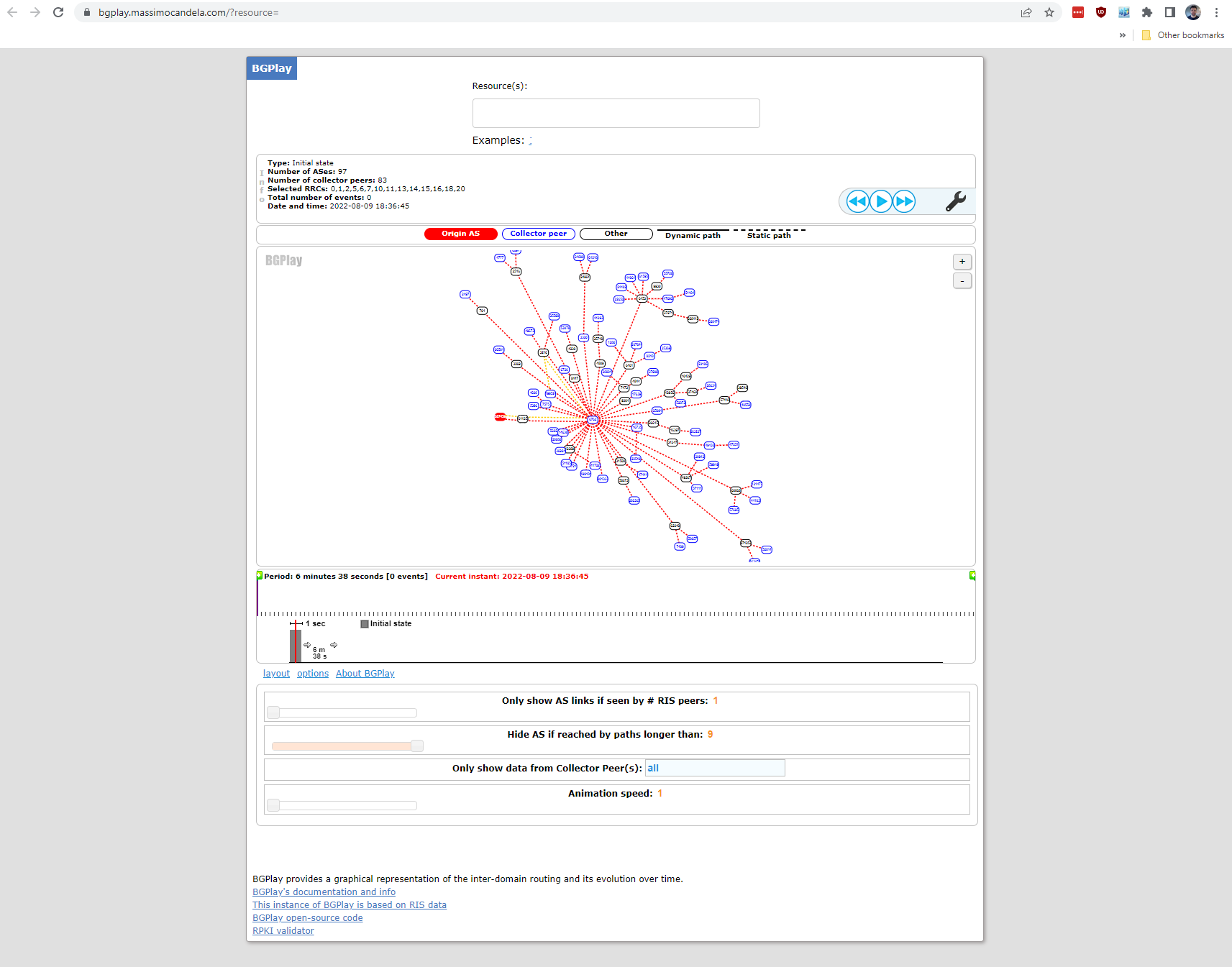
Final Thoughts
As a Network Engineer, I often find it hard to grasp abstract concepts of software development. In my experience, the best way to learn these concepts is to port over something you know (like a networking tool) into a new system. Hopefully, this post will help others in their journey. Thanks for reading!
